Abstract
1. Voluntary activation of elbow flexor muscles can be optimal during brief maximal voluntary contractions (MVCs), although central fatigue, a progressive decline in the ability to drive the muscle maximally, develops during sustained or repeated efforts. We stimulated the motor cortex and motor point in human subjects to investigate motor output during fatigue. 2. The increment in force (relative to the voluntary force) produced by stimulation of the motor point of biceps brachii increased during sustained isometric MVCs of the elbow flexors. Motoneuronal output became suboptimal during the contraction, i.e. central fatigue developed and accounted for a small but significant loss of maximal voluntary force. During 3 min MVCs, voluntary activation of biceps fell to an average of 90.7% from an average of > 99%. 3. The increment in force (relative to the voluntary force) produced by magnetic cortical stimulation was initially small (1.0%) but also increased during sustained MVCs to 9.8% (with a 2 min MVC). Thus, cortical output was not optimal at the time of stimulation nor were sites distal to the motor cortex already acting maximally. 4. A sphygmomanometer cuff around the upper arm blocked blood supply to brachioradialis near the end of a sustained MVC and throughout subsequent brief MVCs. Neither maximal voluntary force nor voluntary activation recovered during ischaemia after the sustained MVC. However, fatigue-induced changes in EMG responses to magnetic cortical stimulation recovered rapidly despite maintained ischaemia. 5. In conclusion, during sustained MVCs, voluntary activation becomes less than optimal so that force can be increased by stimulation of the motor cortex or the motor nerve. Complex changes in excitability of the motor cortex also occur with fatigue, but can be dissociated from the impairment of voluntary activation. We argue that inadequate neural drive effectively 'upstream' of the motor cortex must be one site involved in the genesis of central fatigue.
Full text
PDF
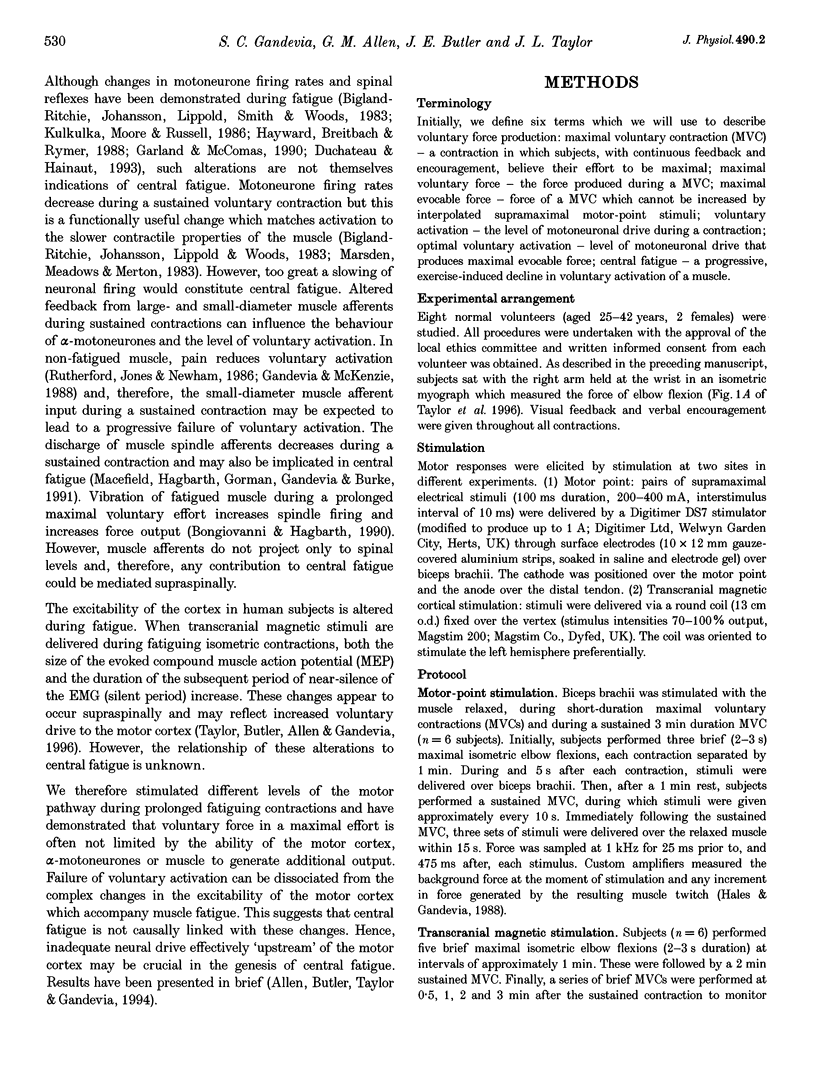
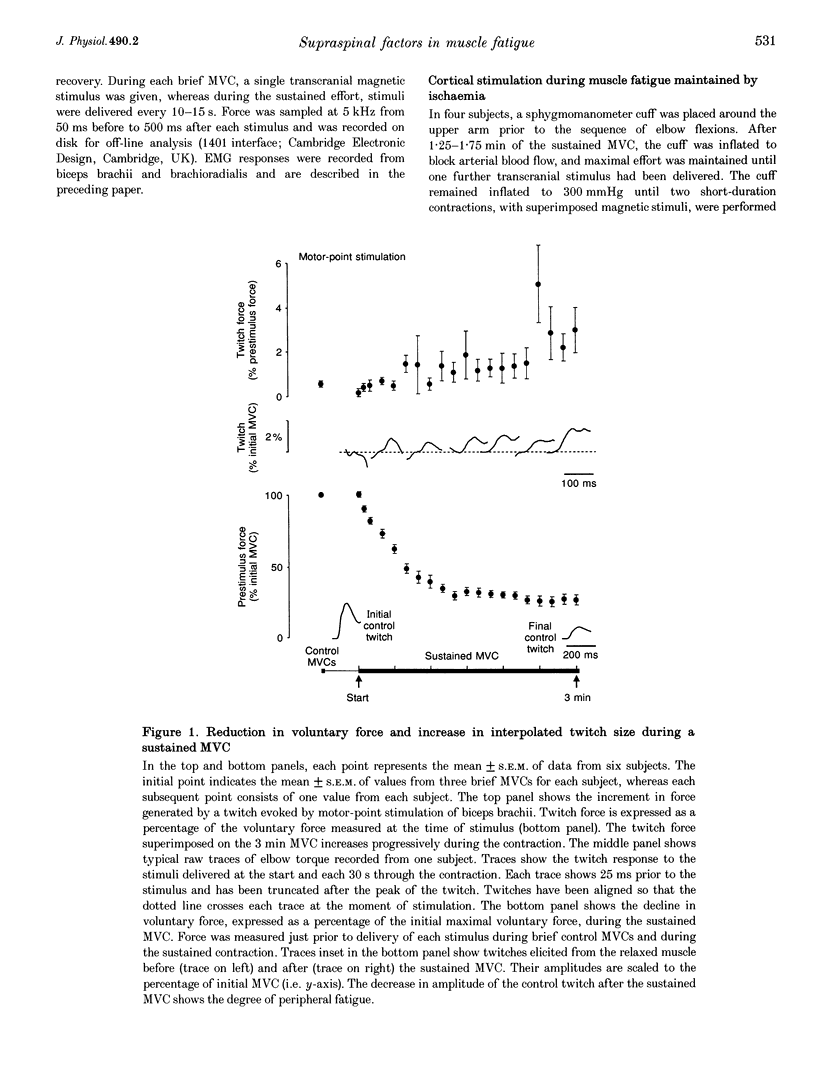
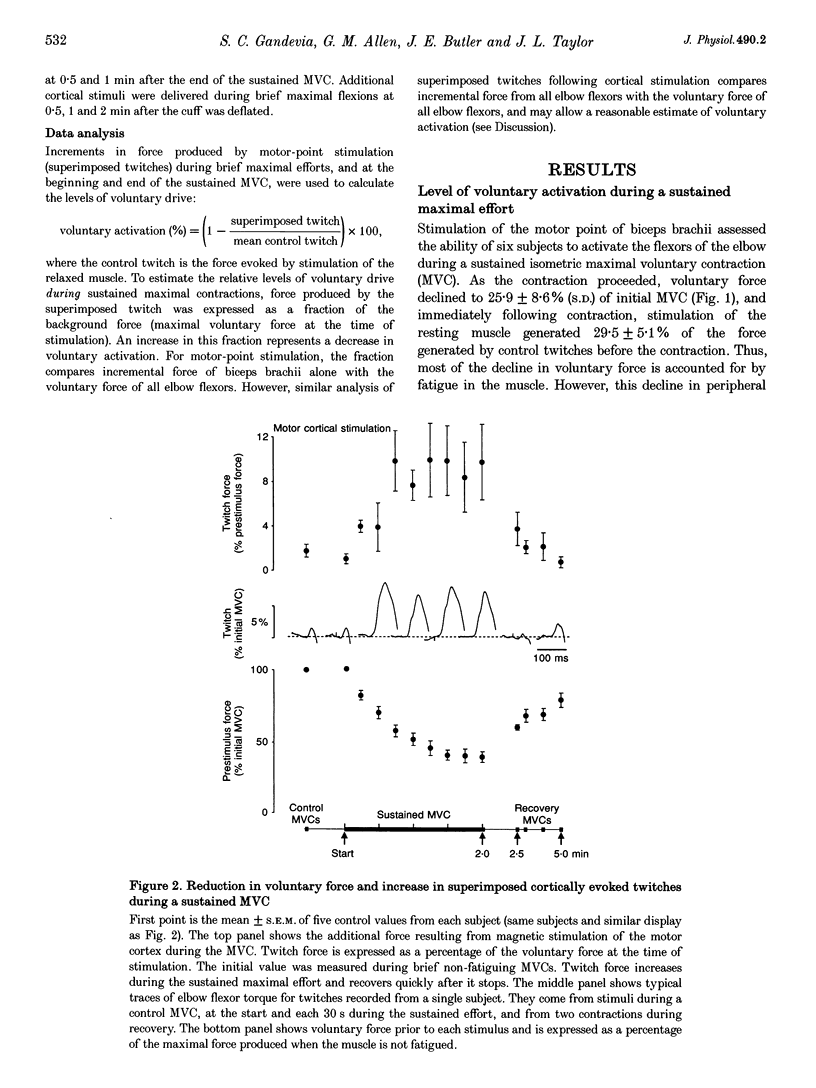
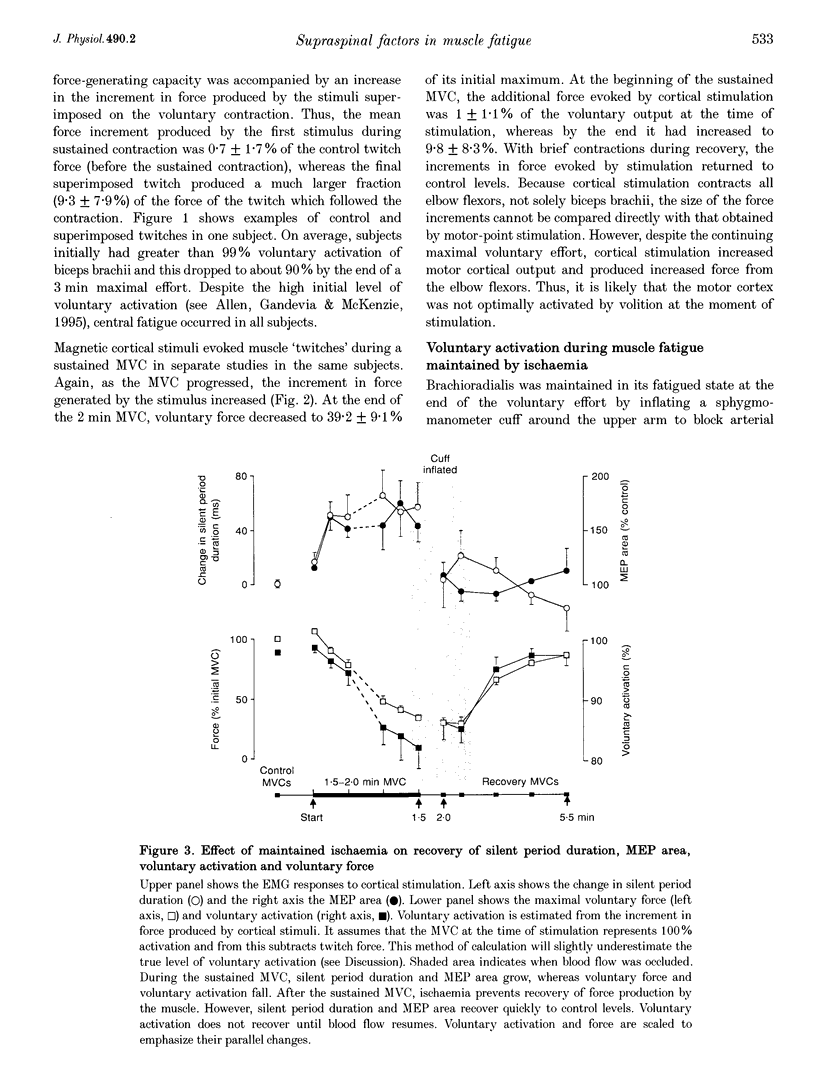


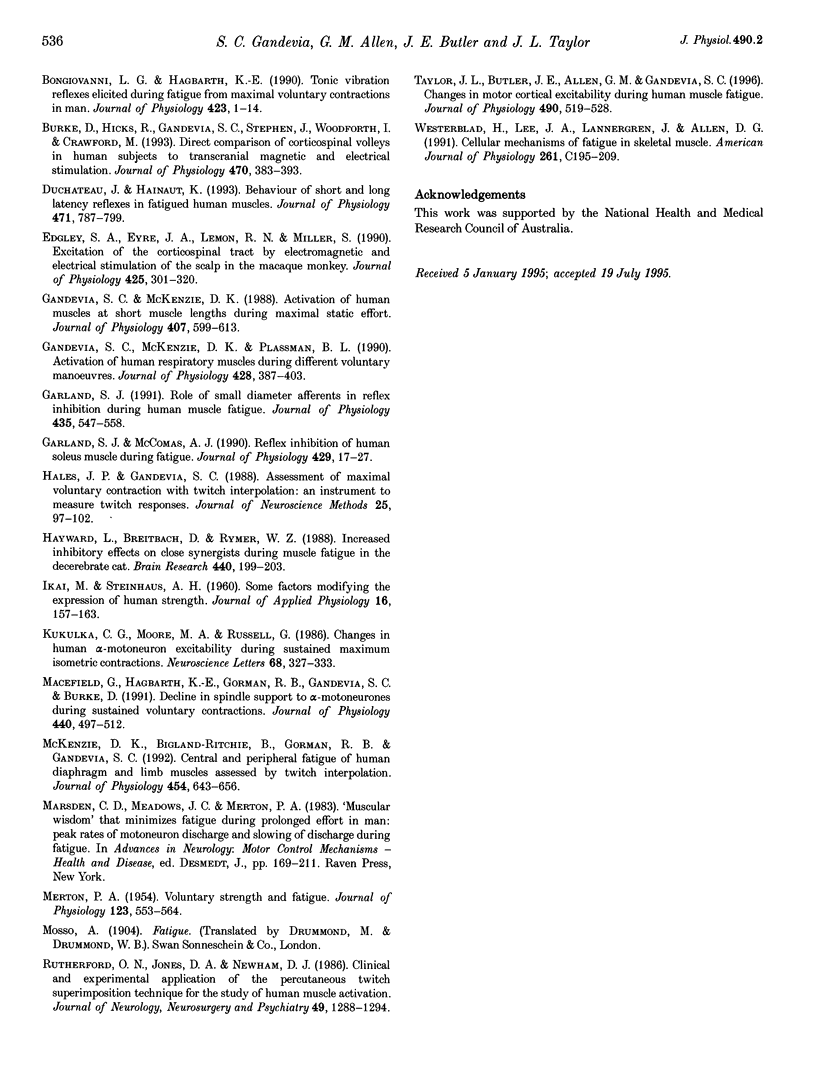
Selected References
These references are in PubMed. This may not be the complete list of references from this article.
- Allen G. M., Gandevia S. C., McKenzie D. K. Reliability of measurements of muscle strength and voluntary activation using twitch interpolation. Muscle Nerve. 1995 Jun;18(6):593–600. doi: 10.1002/mus.880180605. [DOI] [PubMed] [Google Scholar]
- Belanger A. Y., McComas A. J. Extent of motor unit activation during effort. J Appl Physiol Respir Environ Exerc Physiol. 1981 Nov;51(5):1131–1135. doi: 10.1152/jappl.1981.51.5.1131. [DOI] [PubMed] [Google Scholar]
- Bellemare F., Woods J. J., Johansson R., Bigland-Ritchie B. Motor-unit discharge rates in maximal voluntary contractions of three human muscles. J Neurophysiol. 1983 Dec;50(6):1380–1392. doi: 10.1152/jn.1983.50.6.1380. [DOI] [PubMed] [Google Scholar]
- Bigland-Ritchie B. R., Dawson N. J., Johansson R. S., Lippold O. C. Reflex origin for the slowing of motoneurone firing rates in fatigue of human voluntary contractions. J Physiol. 1986 Oct;379:451–459. doi: 10.1113/jphysiol.1986.sp016263. [DOI] [PMC free article] [PubMed] [Google Scholar]
- Bigland-Ritchie B., Johansson R., Lippold O. C., Smith S., Woods J. J. Changes in motoneurone firing rates during sustained maximal voluntary contractions. J Physiol. 1983 Jul;340:335–346. doi: 10.1113/jphysiol.1983.sp014765. [DOI] [PMC free article] [PubMed] [Google Scholar]
- Bigland-Ritchie B., Johansson R., Lippold O. C., Woods J. J. Contractile speed and EMG changes during fatigue of sustained maximal voluntary contractions. J Neurophysiol. 1983 Jul;50(1):313–324. doi: 10.1152/jn.1983.50.1.313. [DOI] [PubMed] [Google Scholar]
- Bigland-Ritchie B., Jones D. A., Hosking G. P., Edwards R. H. Central and peripheral fatigue in sustained maximum voluntary contractions of human quadriceps muscle. Clin Sci Mol Med. 1978 Jun;54(6):609–614. doi: 10.1042/cs0540609. [DOI] [PubMed] [Google Scholar]
- Burke D., Hicks R., Gandevia S. C., Stephen J., Woodforth I., Crawford M. Direct comparison of corticospinal volleys in human subjects to transcranial magnetic and electrical stimulation. J Physiol. 1993 Oct;470:383–393. doi: 10.1113/jphysiol.1993.sp019864. [DOI] [PMC free article] [PubMed] [Google Scholar]
- Duchateau J., Hainaut K. Behaviour of short and long latency reflexes in fatigued human muscles. J Physiol. 1993 Nov;471:787–799. doi: 10.1113/jphysiol.1993.sp019928. [DOI] [PMC free article] [PubMed] [Google Scholar]
- Edgley S. A., Eyre J. A., Lemon R. N., Miller S. Excitation of the corticospinal tract by electromagnetic and electrical stimulation of the scalp in the macaque monkey. J Physiol. 1990 Jun;425:301–320. doi: 10.1113/jphysiol.1990.sp018104. [DOI] [PMC free article] [PubMed] [Google Scholar]
- Gandevia S. C., McKenzie D. K. Activation of human muscles at short muscle lengths during maximal static efforts. J Physiol. 1988 Dec;407:599–613. doi: 10.1113/jphysiol.1988.sp017434. [DOI] [PMC free article] [PubMed] [Google Scholar]
- Gandevia S. C., McKenzie D. K., Plassman B. L. Activation of human respiratory muscles during different voluntary manoeuvres. J Physiol. 1990 Sep;428:387–403. doi: 10.1113/jphysiol.1990.sp018218. [DOI] [PMC free article] [PubMed] [Google Scholar]
- Garland S. J., McComas A. J. Reflex inhibition of human soleus muscle during fatigue. J Physiol. 1990 Oct;429:17–27. doi: 10.1113/jphysiol.1990.sp018241. [DOI] [PMC free article] [PubMed] [Google Scholar]
- Garland S. J. Role of small diameter afferents in reflex inhibition during human muscle fatigue. J Physiol. 1991 Apr;435:547–558. doi: 10.1113/jphysiol.1991.sp018524. [DOI] [PMC free article] [PubMed] [Google Scholar]
- Hales J. P., Gandevia S. C. Assessment of maximal voluntary contraction with twitch interpolation: an instrument to measure twitch responses. J Neurosci Methods. 1988 Sep;25(2):97–102. doi: 10.1016/0165-0270(88)90145-8. [DOI] [PubMed] [Google Scholar]
- Hayward L., Breitbach D., Rymer W. Z. Increased inhibitory effects on close synergists during muscle fatigue in the decerebrate cat. Brain Res. 1988 Feb 2;440(1):199–203. doi: 10.1016/0006-8993(88)91178-x. [DOI] [PubMed] [Google Scholar]
- IKAI M., STEINHAUS A. H. Some factors modifying the expression of human strength. J Appl Physiol. 1961 Jan;16:157–163. doi: 10.1152/jappl.1961.16.1.157. [DOI] [PubMed] [Google Scholar]
- Kukulka C. G., Moore M. A., Russell A. G. Changes in human alpha-motoneuron excitability during sustained maximum isometric contractions. Neurosci Lett. 1986 Aug 4;68(3):327–333. doi: 10.1016/0304-3940(86)90511-2. [DOI] [PubMed] [Google Scholar]
- MERTON P. A. Voluntary strength and fatigue. J Physiol. 1954 Mar 29;123(3):553–564. doi: 10.1113/jphysiol.1954.sp005070. [DOI] [PMC free article] [PubMed] [Google Scholar]
- Macefield G., Hagbarth K. E., Gorman R., Gandevia S. C., Burke D. Decline in spindle support to alpha-motoneurones during sustained voluntary contractions. J Physiol. 1991;440:497–512. doi: 10.1113/jphysiol.1991.sp018721. [DOI] [PMC free article] [PubMed] [Google Scholar]
- McKenzie D. K., Bigland-Ritchie B., Gorman R. B., Gandevia S. C. Central and peripheral fatigue of human diaphragm and limb muscles assessed by twitch interpolation. J Physiol. 1992 Aug;454:643–656. doi: 10.1113/jphysiol.1992.sp019284. [DOI] [PMC free article] [PubMed] [Google Scholar]
- Westerblad H., Lee J. A., Lännergren J., Allen D. G. Cellular mechanisms of fatigue in skeletal muscle. Am J Physiol. 1991 Aug;261(2 Pt 1):C195–C209. doi: 10.1152/ajpcell.1991.261.2.C195. [DOI] [PubMed] [Google Scholar]


